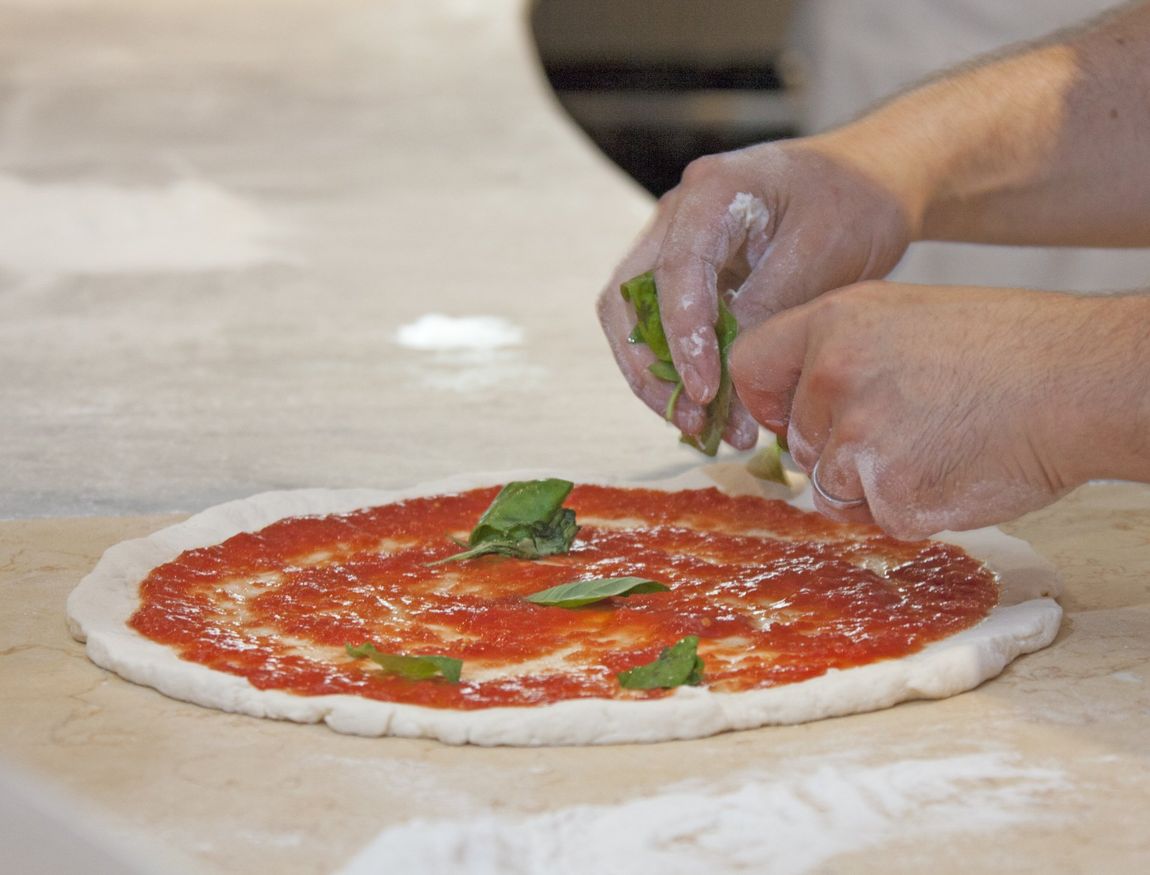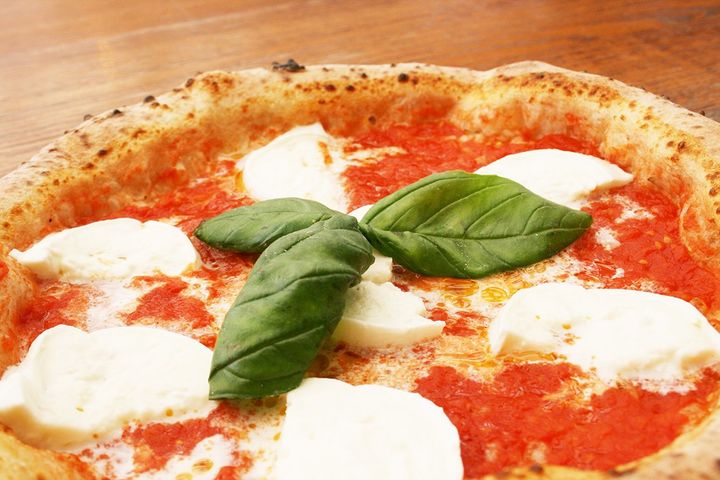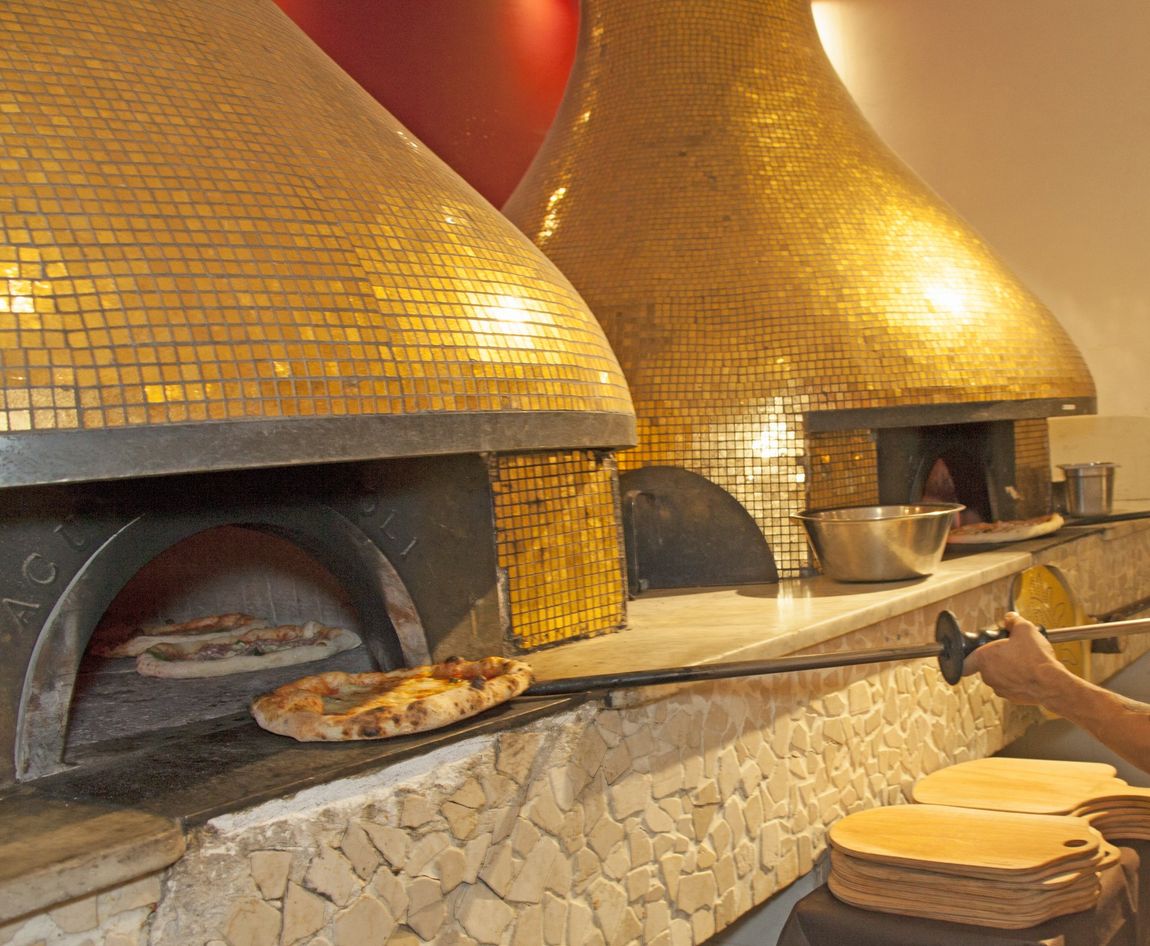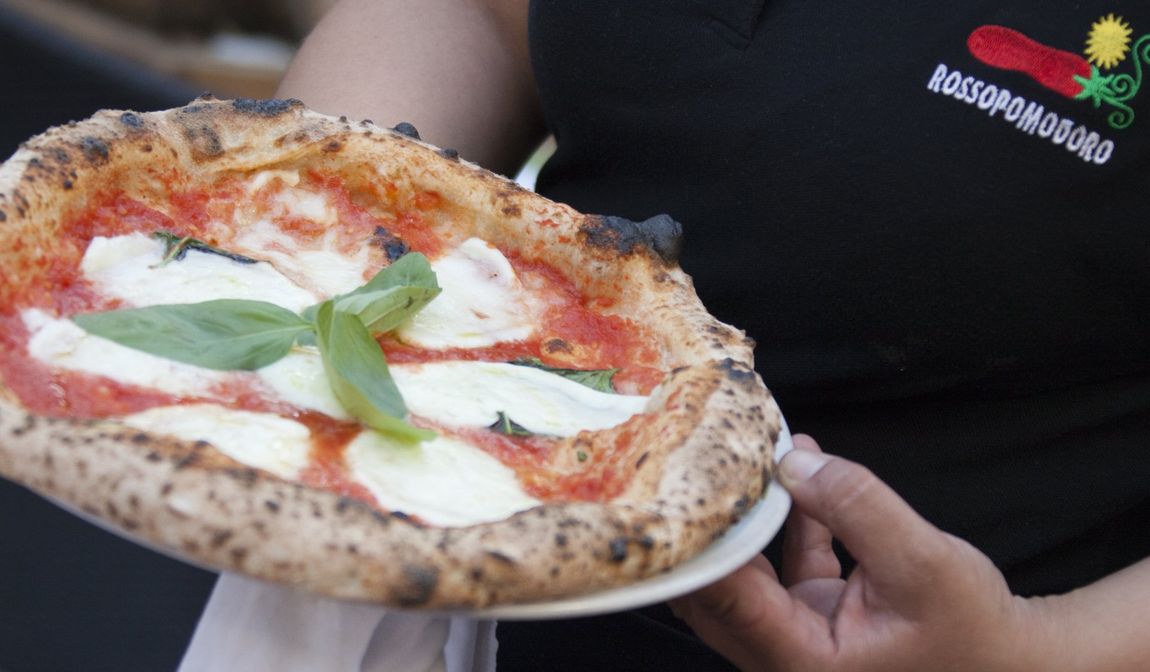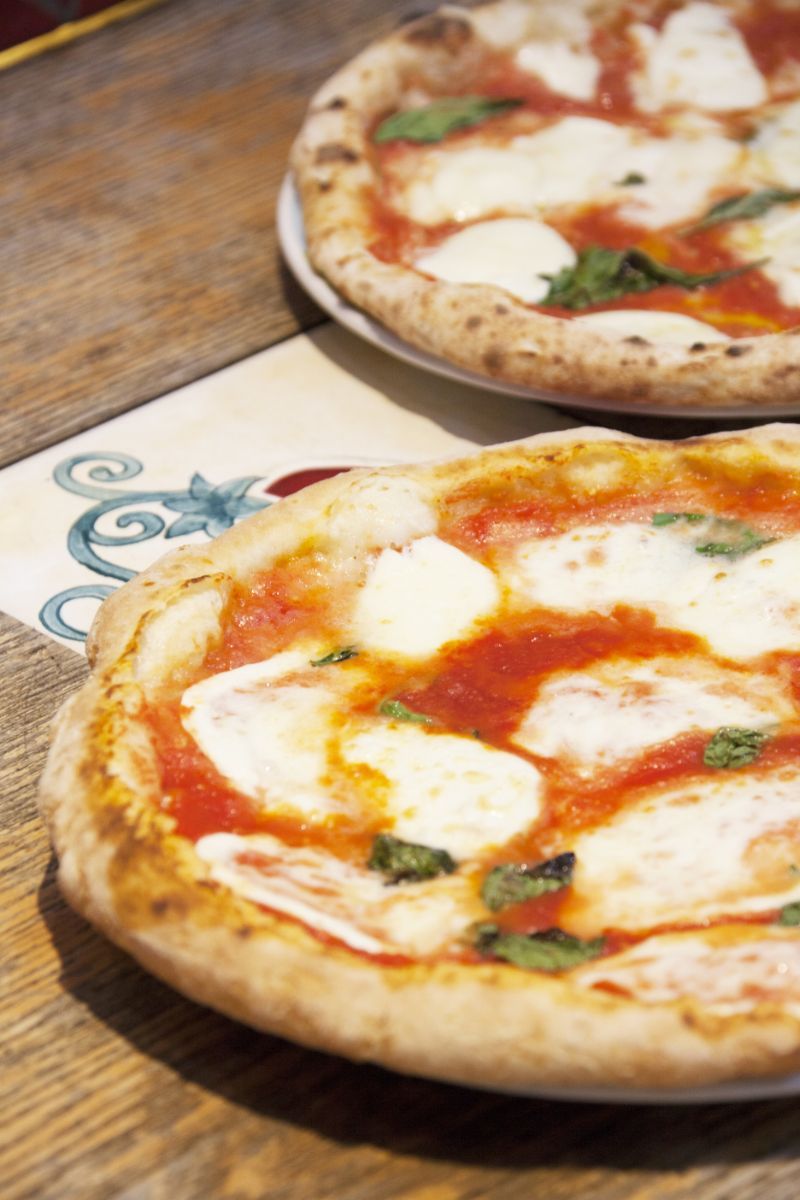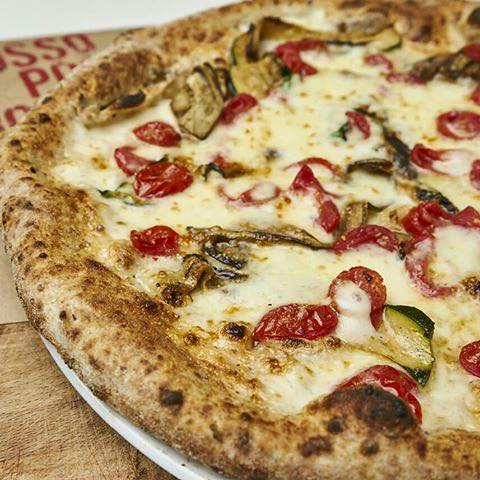NEAPOLITAN PIZZA AND THE GOLDEN OVEN
We have been bringing the values and taste of true Neapolitan pizza to Rimini since 2008. Our pizzaioli, all of Neapolitan origin, led by the multi-award-winning Ferdinando Percoco, use only fresh products from selected producers and follow a rigorous process that starts from the processing to the leavening for 24 hours and baking in Rossopomodoro's patented golden and characteristic wood-fired oven . The result is a pizza that is thin and digestible but full of flavor, with a soft and fragrant crust as per tradition that is highly appreciated by our guests. In addition, thanks to the passion of Angelo Ianniello, this year's winner at the "World Gluten Free Gourmet Pizza Championship," we can also offer our pizzas with special flours without lowering the product quality.
THE HISTORY OF PIZZA
The history of pizza has origins that are lost in antiquity: since Neolithic times there was a custom of baking discs of bread with ingredients on top, a practice that evolved to give rise to pizza in the bettole of Naples and its more modern form in pizza Margherita.
It is a product with a worldwide turnover of more than 60 billion euros, which sees the variety and number of customers wanting to taste top-quality pizza increase day by day.
The success of this gastronomic dish is such that it has recently been recognized as a UNESCO World Heritage Site.
THE INTRODUCTION OF LEAVENING
Since the Neolithic period, humans had discovered that they could create nutritious foods by resting a disk of toasted grains on stovetops. These were mostly vegetables grown directly by man, using simple and crude means: spelt, barley, legumes and flax.
To have the first leavening, a fundamental step in the preparation of an excellent pizza, we will have to wait for the intervention of the Egyptians: this was the first people to discover that grains ground and left to rest became tastier and more digestible after cooking, effectively creating the first form of bread.
BIRTH OF THE TERM IN THE 6TH CENTURY AD.
The next step is the introduction of wheat into European crops by the ancient Romans: farmers used to grind wheat grains with water, salt and herbs, then forming a round flatbread to be baked on the hearth. But we have to reach the invasions of the Lombards for the introduction of the Germanic term "bizzen," which meant bite: linguists identify this term as the origin of the more modern "pizza."
In fact, the term "piza" first appears, referring to a flatbread, in the Codex Cajetanus of Gaeta, a medieval Latin text. Preserved in the Gaeta Cathedral there it is recorded how each year tenants had to pay their landlords "duodecim pizze" at Christmas and Easter in addition to the regular rent.
Around the year 1,000 the use of the term picea is recorded, referring to a disc of dough covered with colored ingredients before being sent to the oven: a term that could have been a synonym to the alternative to the more common pizza, which was already widespread throughout southern Italy to also refer to baked seasoned schiacciate, stuffed focaccias and stuffed and fried discs of dough.
Pizza is also mentioned in a document from Penne in Abruzzo dated 1195.
THE SPREAD DURING THE MEDIEVAL PERIOD
From 1300 onward the use of the term pizza spreads further: in the Roman Curia we read "in bakery, scilicet guindalis, pizi, caseo, lignis in a text from L'Aquila "pissas quatuor et fladonem unum" with reference to fladone, a typical product from Abruzzo and Molise "piczas casey, pizzas de pane" from a document from Celano dated 1387-88 "piza panis" is used in the Pesaro chancery of 1531.
NEAPOLITAN ORIGINS AND BASIL
The spread of the term pizza then became inexorable, where in Naples it even replaced the term focaccia according to the poet and essayist Benedetto di Falco.
In 1570 Bartolomeo Scappi, then personal cook to Pope Pius V, mentions pizza in his Opera but refers to a dessert made by pounding almonds, pine nuts and dates in a ladle, also adding fresh figs, raisins with rosewater, sugar, cinnamon, grape must and egg yolk. But he emphasizes how the basic principle always remains "in it pizza you can put d'ogni sorte condite." Arriving in the seventeenth century is the Cunto de li Cunti, a Neapolitan operetta written by Giovan Battista Basile composed of short stories linked to one another: one is entitled "the two pizzelle" and reads in one passage, "among so much, her husband having left, she, who was so cannaruta as potrona, did not wait for anything else but to take mappate de farina and garlic of oil and to make zeppole and fried pizzas." Meanwhile, the recipe for the traditional schiacciata evolved and refined, spreading throughout the South: olive oil replaced lard, cheese and herbs were added. This is the period when basil makes its appearance in pizza "alla Mastunicola" (by master Nicola) and will never leave the ingredient list again, remaining a symbol of Neapolitan pizza today.
FROM THE PEOPLE'S TABLES TO THE NOBLE ONES
The arrival of the tomato around the second half of the 1700s is the next step in the completion of the modern pizza: initially used only as a decorative plant this fruit native to Central America will become the star of Italian tables, appearing first on pizza and then, in 1773, on macaroni. As evidence of the Neapolitans' custom of seasoning pasta and pizza with tomato we have the written testimony of the Italian philosopher and man of letters Vincenzo Corrado. It had been until that time a poor dish, preferred by the people and finding no place on the tables of the nobles: something changed with the arrival of Ferdinand I of Bourbon, who had it tasted by his consort Maria Carolina and his ladies of the court with some success. Some pottery used to bake pizza dates from that period, probably used by Antonio Testa, Naples' best pizza maker, who was hired as court cook. From 1858, on the other hand, there is a text describing the recipe and procedure for the preparation of the true Neapolitan pizza: it spoke precisely about how to treat and roll out the dough, using a rolling pin or the hands to make it soft and appetizing.
THE TERM PIZZA MAKER AND THE QUEEN MARGHERITA
Francis de Bourcard also mentions it in his Usi e Costumi di Napoli, an author who also seems to mention a kind of pizza margherita ante litteram: "...they are covered with grated cheese and seasoned with lard, and a few basil leaves are placed on top. Thin slices of mozzarella cheese are added."
The term pizzaiolo, also present in the 1922 Zingaretti as "one who makes and sells pizzas in Naples," was introduced in 1884, and the first attempts to export this gastronomic product outside its city of origin were also born. In fact, Matilde Serao tells how a Neapolitan industrialist tried to open a pizzeria in Rome, but failed miserably after a positive start: outside of Naples, pizza continued to seem completely out of place.
It is from June 1889 that legend has it how chef Raffaele Esposito, owner of the Brandi pizzeria, proposed the first version of the Margherita pizza to Umberto I di's wife, Margherita di Savoia. Her favorite was the one that took its name, which was the pizza topped with tomatoes, mozzarella and basil designed to represent the tricolor as well.
The other pizzas cooked on that occasion were: the white one with lard, basil and pepper, called Mastu Nicolala tomato, anchovies, garlic, oregano and oil fried calzone with ricotta and cicoli.
PIZZA AND CULTURE SPREAD
Approaching the present day, references to pizza increase in so many cultural contexts: in 1891 Pellegrino Artusi reports three types of sweet pizza in his classic work "Science in the Kitchen and the Art of Eating Well." In 1900 Raffaele de Cesare wrote in his historical essay La fine di un regno the passage "Frederick II, Neapolitan in everything, liked those coarse foods, of which the Neapolitans are fond: baccalà, soffritto, caponata, mozzarella, pizzas." In 1905 there appeared in the Modern Dictionary published by Hoepli the words "Pizza: a vulgar name for a very popular Neapolitan food."
THE VOCABULARY AND ORIGINAL RECIPES
The Vocabolario Etimologico della Lingua Italiana (Etymological Vocabulary of the Italian Language) suggested in 1907 that the term pizza derives from the Latin "pinza/pinsere," meaning to crush, which is also the term used for a baked, flour and dried fruit dessert of Veneto and Friuli origin. Others suggest it derives from the medieval Greek "pita." In the collection of regional recipes written by Ada Boni in 1929 (The Talisman of Happiness) a recipe for canonical pizza is included. In May 1984 old Neapolitan pizza makers gathered at the notary Antonio Carannante's office to sign a brief specification on the rules for making the dough. In 2004, the Italian Parliament established precisely what types of flour, yeast, salt and tomatoes can be used to make the real Margherita pizza, stipulating that mozzarella cheese must necessarily come from traditional geographical areas.
UNESCO WORLD HERITAGE PIZZA
The latest international news on pizza relates to its recognition as a Traditional Specialty of the European Union on Feb. 5, after a 2009 vote in which for unknown reasons only Poland abstained. The traditional recipe and the ingredients that make it so are determined, but the real pizza remains the one that can be eaten in Naples, with ingredients grown in that region and with top-quality buffalo mozzarella. Even today despite all the varieties and ingredients used, the true recognized recipe is the traditional one, and more elaborate pizzas are almost considered stomach-damaging by Neapolitan pizza makers. The success of pizza continues unchallenged: in 2010 Julia Roberts tastes one in the film Eat, Pray, Love. A true, traditional pizza is enshrined in the world thanks to cinema, with a scene filmed in the Antica pizzeria da Michele in Forcella, Naples' historic working-class neighborhood. A family of pizza-making tradition, it will later open in Rome in Via Famiglia, in Japan in Tokyo and Fukuoka, in London on Baker Street, in Barcelona and also replace the restaurant opened in Milan by Joe Bastianich and Belen Rodriguez. The latest recognition of pizza in the world took place Dec. 4-8, 2017 in South Korea, where the UNESCO Intergovernmental Committee listed it as a cultural heritage to be safeguarded after a 7-year process.





